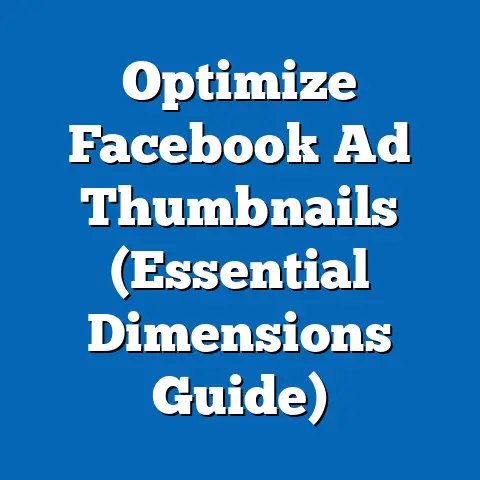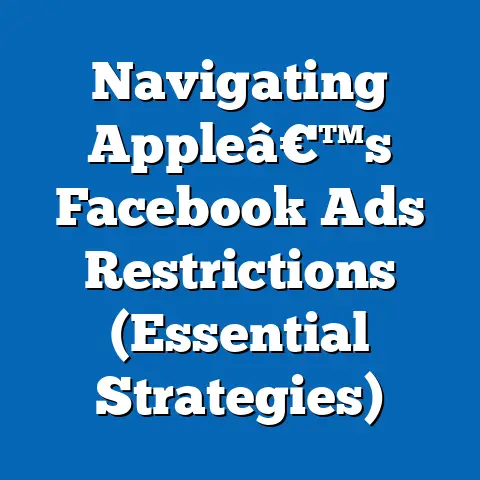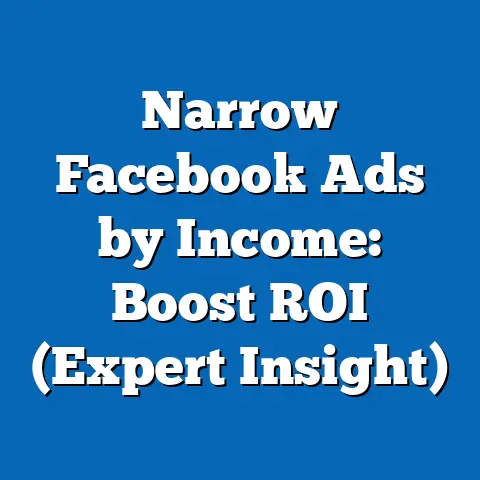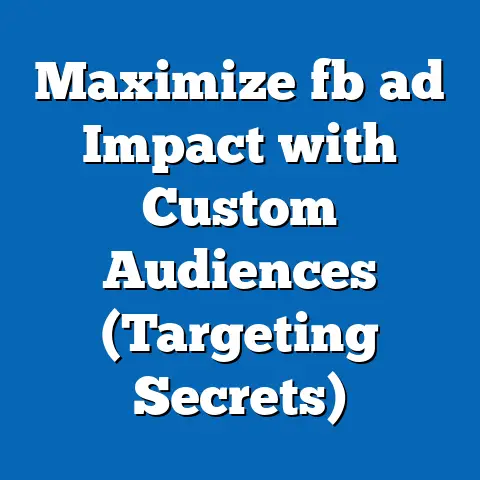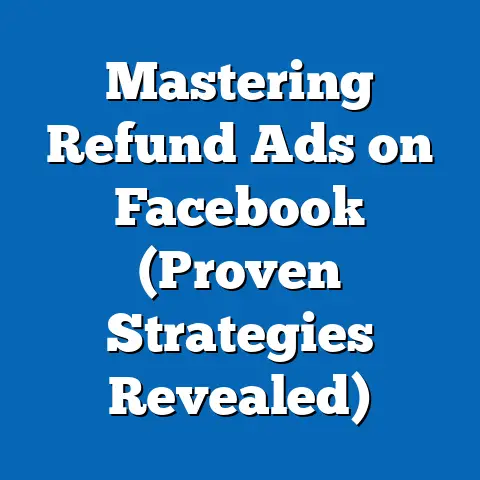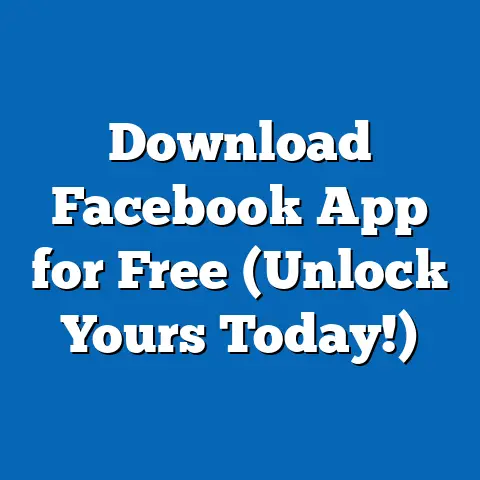Unlock Hidden Lead Sources in Facebook Ads (Proven Strategies)
I’ve spent years navigating the ever-changing world of Facebook Ads, and one thing I’ve learned is that relying on the same old tactics simply won’t cut it. In the current digital marketing landscape, if you’re not actively searching for and tapping into the hidden lead sources within Facebook Ads, you’re essentially leaving money on the table. Imagine discovering untapped pools of potential customers just waiting to hear about your product or service – that’s the power of uncovering these elusive lead sources.
Understanding Facebook’s Ad Ecosystem
Before we start digging for hidden treasure, let’s make sure we’re all on the same page regarding the basics of Facebook Ads.
Overview of Facebook Ads
Facebook Ads, at their core, are paid messages that businesses use to reach a specific audience on Facebook and its related platforms (like Instagram). They’re a powerful tool in digital marketing because they allow for precise targeting based on demographics, interests, behaviors, and more. Think of them as a digital megaphone, but instead of shouting into a crowd, you’re speaking directly to the people most likely to be interested in what you have to offer.
There’s a wide array of ad formats available, from simple image ads and video ads to more interactive options like carousel ads and lead generation forms. The key is choosing the right format for your specific goal and audience. Targeting options are equally diverse, allowing you to narrow down your audience based on factors like age, location, interests, job title, and even behaviors like online purchases or travel habits. I remember one campaign where we targeted users who had recently engaged with content related to sustainable living – the results were phenomenal!
Importance of Lead Sources
In the context of Facebook Ads, a lead source is simply the origin of a potential customer. It’s the “where” or “how” you found the people who are likely to become paying customers. Understanding where your leads are coming from is absolutely crucial for marketers. It allows you to focus your efforts and resources on the most effective channels and strategies.
Now, there’s a crucial distinction to be made between visible and hidden lead sources. Visible lead sources are the ones that are immediately obvious – the demographics you’ve explicitly targeted, the interests you’ve selected, the custom audiences you’ve uploaded. Hidden lead sources, on the other hand, are less apparent. They’re the unexpected connections, the nuanced behaviors, the untapped segments that you might not have considered initially.
For example, you might be targeting “small business owners” as a broad interest. A hidden lead source might be discovering that small business owners who are also members of specific online communities (related to entrepreneurship or a specific industry) are significantly more likely to convert. Uncovering these hidden gems is where the real magic happens.
Takeaway: Facebook Ads offer incredible targeting capabilities. Understanding the difference between visible and hidden lead sources is key to maximizing your ROI.
Identifying Hidden Lead Sources
Okay, now we’re getting to the exciting part: the treasure hunt! Let’s explore some proven methods for uncovering those hidden lead sources within Facebook Ads.
Exploring Audience Insights
Facebook Audience Insights is a goldmine of information about your target audience. It allows you to delve deep into their demographics, interests, behaviors, and even their purchasing habits. I’ve spent countless hours poring over Audience Insights data, and it’s consistently revealed unexpected connections and untapped segments.
To access Audience Insights, navigate to your Ads Manager and select “Audience Insights” from the “Tools” menu. From there, you can choose to analyze everyone on Facebook or people connected to your page. I typically start by analyzing everyone on Facebook to get a broad overview of potential audiences.
One of the most powerful features of Audience Insights is its ability to reveal hidden demographics and interests. For example, you might be targeting “yoga enthusiasts,” but Audience Insights could reveal that a significant portion of that audience is also interested in “organic gardening” or “meditation.” This opens up new avenues for targeting and ad messaging.
I remember one instance where we were promoting a new line of sustainable clothing. We initially targeted users interested in “eco-friendly products.” However, Audience Insights revealed that a large segment of our target audience was also interested in “minimalist living” and “slow fashion.” By incorporating these interests into our targeting, we saw a significant boost in ad performance.
Utilizing Custom Audiences
Custom Audiences are another incredibly powerful tool for unlocking hidden lead sources. They allow you to create audiences based on your own data, such as website visitors, email lists, customer data, and more. This is where you can truly tap into the power of your existing customer base and leverage their behaviors to find new potential leads.
There are several types of Custom Audiences you can create:
- Website Custom Audiences: These audiences are created based on the actions people take on your website. You can target users who have visited specific pages, spent a certain amount of time on your site, or added items to their cart but didn’t complete the purchase.
- Customer List Custom Audiences: These audiences are created by uploading a list of customer email addresses or phone numbers. This allows you to target your existing customers with relevant ads or create lookalike audiences based on their characteristics.
- Engagement Custom Audiences: These audiences are created based on people’s interactions with your Facebook or Instagram content. You can target users who have watched your videos, engaged with your posts, or visited your Facebook page.
One of the most effective ways to leverage Custom Audiences is to create Lookalike Audiences. Lookalike Audiences allow you to find new people who are similar to your existing customers or website visitors. Facebook analyzes the characteristics of your source audience (e.g., your top 10% of customers) and identifies other users who share similar traits. This can be a game-changer for discovering new potential leads.
I’ve seen countless campaigns where Lookalike Audiences have outperformed traditional targeting methods. The key is to use a high-quality source audience – the more accurate and relevant your source audience, the better your Lookalike Audience will be.
Engagement Metrics
Your existing Facebook posts and ads are a treasure trove of information about potential leads. By carefully analyzing engagement metrics like comments, shares, and reactions, you can identify users who are already interested in your offerings and tailor your messaging to them.
Pay close attention to the comments section of your posts and ads. Are people asking questions about your product or service? Are they expressing interest in learning more? These are all potential leads who are just waiting to be nurtured.
Similarly, look at the users who are sharing your posts and ads. These are people who are not only interested in your content but also willing to spread the word to their own networks. Consider reaching out to them directly or creating a targeted campaign to reward their engagement.
Even simple reactions like “likes” and “loves” can provide valuable insights. If a user consistently interacts with your content, they’re likely a good candidate for a more targeted campaign.
Takeaway: Facebook Audience Insights, Custom Audiences, and engagement metrics are powerful tools for identifying hidden lead sources. Don’t underestimate the power of data!
Proven Strategies to Unlock Hidden Lead Sources
Now that we’ve identified some potential hidden lead sources, let’s explore some proven strategies for unlocking them and converting them into paying customers.
A/B Testing
A/B testing, also known as split testing, is the process of comparing two versions of an ad (or any marketing element) to see which one performs better. It’s a crucial tool for uncovering hidden leads because it allows you to experiment with different ad creatives, targeting options, and messaging to see what resonates best with your audience.
I’ve found that even small changes in your ads can have a significant impact on performance. For example, changing the headline, image, or call-to-action can all lead to a noticeable increase in click-through rates and conversions.
To effectively conduct A/B tests on Facebook Ads, follow these steps:
- Define your hypothesis: What are you trying to test? Are you trying to determine which headline resonates best with your audience? Or which image generates the most clicks?
- Create two versions of your ad: Change only one element at a time. This will allow you to isolate the impact of that specific element.
- Set up your A/B test: In Ads Manager, select the “Create A/B Test” option. Follow the prompts to set up your test parameters, including your budget, duration, and target audience.
- Analyze the results: Once your test is complete, analyze the results to see which version performed better. Pay attention to metrics like click-through rate, conversion rate, and cost per conversion.
- Implement the winning version: Use the winning version of your ad in your ongoing campaigns.
A/B testing is an ongoing process. You should continuously be testing different elements of your ads to optimize performance and uncover new hidden lead sources.
Retargeting Campaigns
Retargeting is the practice of showing ads to people who have previously interacted with your website or Facebook page. It’s a powerful tool for accessing previously untapped lead sources because it allows you to re-engage users who have already shown interest in your brand.
I like to think of retargeting as a second chance to make a good impression. Maybe a user visited your website but didn’t make a purchase. Maybe they added an item to their cart but abandoned the checkout process. Retargeting allows you to bring them back into the fold and nudge them towards conversion.
Here are some specific strategies for creating retargeting campaigns that convert:
- Target website visitors who haven’t made a purchase: Show them ads that highlight the benefits of your product or service and offer a special discount.
- Target users who abandoned their cart: Remind them of the items they left behind and offer free shipping or a limited-time discount to incentivize them to complete the purchase.
- Target users who watched your videos: Show them ads that promote related products or services.
- Target users who engaged with your Facebook page: Offer them exclusive content or promotions.
The key to successful retargeting is to personalize your ads and make them relevant to the user’s previous interactions with your brand.
Utilizing Facebook Groups
Facebook Groups can be a goldmine for hidden leads, especially if you’re in a niche market. These groups are communities of people who share a common interest, and they can be a great place to connect with potential customers and build relationships.
I’ve seen businesses generate significant leads by actively participating in relevant Facebook Groups. The key is to be authentic and provide value. Don’t just spam the group with promotional messages. Instead, focus on sharing helpful information, answering questions, and engaging in meaningful conversations.
Here are some tips for engaging with groups relevant to your niche and converting members into leads:
- Find relevant groups: Search for groups that are related to your industry or target audience.
- Join the conversation: Participate in discussions, answer questions, and share your expertise.
- Offer valuable content: Share helpful articles, videos, or resources that are relevant to the group’s interests.
- Build relationships: Connect with other members of the group and build genuine relationships.
- Promote your products or services subtly: When appropriate, mention your products or services in a relevant context.
Remember, the goal is to build trust and establish yourself as a valuable member of the community. Over time, this will lead to new leads and customers.
Leveraging User-Generated Content
User-generated content (UGC) is any content – such as images, videos, or reviews – that is created by your customers or fans. It’s a powerful way to tap into hidden lead sources because it provides social proof and authenticity.
I’ve found that UGC is far more effective than traditional advertising because it comes from real people who are already using and loving your products or services. It’s like a word-of-mouth recommendation on steroids.
Here are some methods for encouraging UGC and how to use it in ads:
- Run contests or giveaways: Encourage customers to submit photos or videos of themselves using your products or services.
- Ask for reviews: Make it easy for customers to leave reviews on your website or Facebook page.
- Feature customer testimonials: Highlight positive reviews and testimonials in your ads.
- Create a hashtag: Encourage customers to share their experiences using a specific hashtag.
When using UGC in your ads, be sure to get permission from the content creator. You can also offer them incentives, such as discounts or free products.
Exploring Influencer Partnerships
Collaborating with influencers can be a game-changer for unlocking new lead sources. Influencers are individuals who have a large and engaged following on social media. They can help you reach a wider audience and build credibility with potential customers.
I’ve seen businesses generate significant leads by partnering with influencers who are relevant to their niche. The key is to find influencers who align with your brand values and who have an audience that is likely to be interested in your products or services.
Here are some strategies for identifying the right influencers and measuring the success of these partnerships:
- Identify your target audience: Who are you trying to reach? What are their interests and behaviors?
- Research potential influencers: Look for influencers who have a large and engaged following within your target audience.
- Evaluate their content: Is their content high-quality and relevant to your brand?
- Check their engagement rates: Are their followers actively engaging with their content?
- Negotiate a partnership: Discuss your goals and expectations with the influencer and agree on a fair price.
- Track the results: Monitor the performance of the influencer’s content, including reach, engagement, and conversions.
Influencer marketing can be a powerful way to unlock hidden lead sources, but it’s important to do your research and choose the right influencers for your brand.
Takeaway: A/B testing, retargeting, Facebook Groups, UGC, and influencer partnerships are all effective strategies for unlocking hidden lead sources. The key is to experiment and find what works best for your business.
Tools and Resources to Aid Discovery
Finding these hidden lead sources can be time consuming. Thankfully, there are great tools and resources that can help.
Ad Manager Tools
Facebook Ads Manager itself offers a suite of tools that can help you identify hidden lead sources.
- Facebook Pixel: This is a crucial tool for tracking website conversions and creating retargeting audiences.
- Audience Insights: As mentioned earlier, this tool allows you to delve deep into the demographics, interests, and behaviors of your target audience.
- Ads Reporting: This tool allows you to track the performance of your ads and identify which campaigns are generating the most leads.
- Attribution: This tool allows you to track the customer journey and understand which touchpoints are contributing to conversions.
Navigating Ads Manager can be overwhelming at first, but with a little practice, you’ll be able to find the insights you need to uncover hidden lead sources.
Third-Party Analytics Tools
In addition to Facebook’s own tools, there are several third-party analytics tools that can help you analyze your Facebook Ads performance and uncover lead sources.
- Google Analytics: This is a free web analytics tool that can provide valuable insights into website traffic and user behavior.
- SEMrush: This is a comprehensive marketing toolkit that includes features for keyword research, competitor analysis, and social media management.
- HubSpot: This is a marketing automation platform that can help you track leads, nurture relationships, and measure the ROI of your marketing efforts.
These tools can provide a more holistic view of your marketing performance and help you identify hidden lead sources that you might have missed using Facebook’s tools alone.
Community Resources
Finally, don’t forget about the power of community. There are countless online communities, forums, and educational resources where marketers share strategies related to Facebook Ads.
- Facebook Groups: Join groups related to Facebook advertising, digital marketing, or your specific industry.
- Online Forums: Participate in discussions on marketing forums like Reddit’s r/marketing or Quora.
- Industry Blogs: Follow blogs and publications that cover Facebook advertising and digital marketing.
- Online Courses: Take online courses on Facebook Ads to improve your skills and knowledge.
Learning from other marketers and sharing your own experiences can be a valuable way to uncover new strategies and insights.
Takeaway: Don’t be afraid to leverage both Facebook’s own tools and third-party resources to aid in your discovery of hidden lead sources.
Conclusion
Unlocking hidden lead sources in Facebook Ads is not a one-time task but an ongoing process of experimentation, analysis, and optimization. By understanding the Facebook Ads ecosystem, identifying potential hidden lead sources, and implementing proven strategies, you can dramatically improve your ad performance and ROI.
Remember, the key strategies we’ve discussed are:
- Exploring Audience Insights
- Utilizing Custom Audiences
- Analyzing Engagement Metrics
- A/B Testing
- Retargeting Campaigns
- Utilizing Facebook Groups
- Leveraging User-Generated Content
- Exploring Influencer Partnerships
I encourage you to implement these strategies in your own Facebook Ads campaigns and share your experiences and results. The world of Facebook advertising is constantly evolving, and by working together, we can all uncover new and innovative ways to unlock hidden lead sources and achieve our marketing goals. So, get out there, start experimenting, and let’s unlock those hidden lead sources together!

